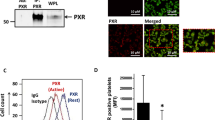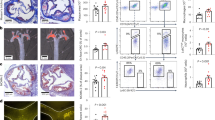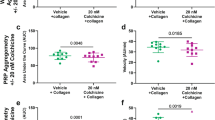Abstract
Prostanoids are a group of bioactive lipids working as local mediators1 and include D, E, F and I types of prostaglandins (PGs) and thromboxanes. Prostacyclin (PGI2) acts on platelets and blood vessels to inhibit platelet aggregation and to cause vasodilatation, and is thought to be important for vascular homeostasis2. Aspirin-like drugs, including indomethacin, which inhibit prostanoid biosynthesis, suppress fever, inflammatory swelling and pain, and interfere with female reproduction, suggesting that prostanoids are involved in these processes1,3, although it is not clear which prostanoid is the endogenous mediator of a particular process. Prostanoids act on seven-transmembrane-domain receptors which are selective for each type4. Here we disrupt the gene for the prostacyclin receptor5 in mice by using homologous recombination. The receptor-deficient mice are viable, reproductive and normotensive. However, their susceptibility to thrombosis is increased, and their inflammatory and pain responses are reduced to the levels observed in indomethacin-treated wild-type mice. Our results establish that prostacyclin is an antithrombotic agent in vivo and provide evidence for its role as a mediator of inflammation and pain.
This is a preview of subscription content, access via your institution
Access options
Subscribe to this journal
Receive 51 print issues and online access
$199.00 per year
only $3.90 per issue
Buy this article
- Purchase on Springer Link
- Instant access to full article PDF
Prices may be subject to local taxes which are calculated during checkout




Similar content being viewed by others
References
Campbell, W. B. & Halushka, P. V. in The Pharmacological Basis of Therapeutics (9th edn) (eds Hardman, J. G. et al.) 601–616 (McGraw-Hill, New York, 1996).
Bunting, S., Moncada, S. & Vane, J. R. The prostacyclin-thromboxane A2balance: pathophysiological and therapeutic implications. Br. Med. Bull. 39, 271–276 (1983).
Davies, P., Bailey, P. J., Goldenberg, M. M. & Ford-Hutchinnson, A. W. The role of arachidonic acid oxygenation products in pain and inflammation. Annu. Rev. Immunol. 2, 335–357 (1984).
Ushikubi, F., Hirata, M. & Narumiya, S. Molecular biology of prostanoid receptors: an overview. J. Lip. Mediat. 12, 343–359 (1995).
Namba, T. et al. cDNA cloning of a mouse prostacyclin receptor. J. Biol. Chem. 269, 9986–9992 (1994).
Morham, S. G. et al. Prostaglandin synthase 2 gene disruption causes severe renal pathology in the mouse. Cell 83, 473–482 (1995).
Armstrong, R. A. et al. Fucntional and ligand binding studies suggest heterogeneity of platelet prostacyclin receptor. Br. J. Pharmacol. 97, 657–668 (1989).
Murata, T. et al. General pharmacology of beraprost sodium: Effect on the autonomic, cardiovascular and gastrointestinal systems, and other effects. Arzneim. Forsch. 39, 867–876 (1989).
Huang, P. L. et al. Hypertension in mice lacking the gene for endothelial nitric oxide synthase. Nature 377, 239–242 (1995).
Kurz, K. D., Main, B. W. & Sandusky, G. E. Rat model of arterial thrombosis induced by ferric chloride. Thromb. Res. 60, 269–280 (1990).
Vadas, P., Wasi, S., Movat, H. Z. & Hay, J. B. Extracellular phospholipase A2mediates inflammatory hyperaemia. Nature 293, 583–585 (1981).
Ferreira, S. H. Inflammatory pain, prostaglandin hyperalgesia and the development of peripheral analgesics. Trends Pharmacol. Sci. 2, 183–186 (1981).
Winter, C. A. & Flataker, L. Reaction thresholds to pressure in edematous hindpaws of rats and responses to analgesic drugs. J. Pharmacol. Exp. Ther. 150, 165–171 (1965).
Utsunomiya, I., Nagai, S. & Oh-ishi, S. Differential effects of indomethacin and dexamethasone on cytokine produciton in carrageenin-induced rat pleurisy. Eur. J. Pharmacol. 252, 213–218 (1994).
Oida, H. et al. In situ hybridization studies of prostacyclin receptor mRNA expression in various mouse organs. Br. J. Pharmacol. 116, 2828–2837 (1995).
Malmberg, A. B. & Yaksh, T. L. Hyperalgesia mediated by spinal glutamate or substance P receptor blocked by spinal cyclooxygenase inhibition. Science 257, 1276–1279 (1992).
Oka, T., Aou, S. & Hori, T. Intracerebroventricular injection of interleukin-1β induces hyperalgesia in rats. Brain Res. 624, 61–68 (1993).
Piercey, M. F. & Schroeder, L. A. Spinal and supraspinal sites for morphine and nefopam analgesia in the mouse. Eur. J. Pharmacol. 74, 135–140 (1981).
Millan, M. J. & Colpaert, F. C. 5-Hydroxytryptamine (5-HT)1Areceptors and the tail-flick response. II. High efficacy 5-HT1Aagonists attenuate morphine-induced antinociception in mice in a competitive-like manner. J. Pharmacol. Exp. Ther. 256, 983–992 (1991).
Koster, R., Anderson, M. & deBeer, E. J. Acetic acid for analgesic screening. Fed. Proc. 18, 412 (1959). FINAL PAGE?
Doherty, N. S. et al. The role of prostaglandins in the nociceptive response induced by intraperitoneal injection of zymosan in mice. Br. J. Pharmacol. 91, 39–47 (1987).
Vane, J. R., Anggard, E. E. & Botting, R. M. Regulatory functions of the vascular endothelium. New Eng. J. Med. 323, 27–36 (1990).
Kawabe, T. et al. The immune responses in CD40-deficient mice: impaired immunoglobulin class switching and germinal center formation. Immunity 1, 167–178 (1994).
Dejana, E., Callioni, A., Quintana, A. & Gaetano, G. Bleeding time in laboratory animals. II—A comparison of different assay conditions in rats. Thromb. Res. 15, 191–197 (1979).
Ritter, J. M., Aksoy, A., Cragoe, E. J. & Taylor, G. W. Actions of amiloride analogues on prostacyclin synthesis by rat aortic rings. Br. J. Pharmacol. 92, 857–862 (1987).
Ueno, A., Tokumasu, T., Naraba, H. & Oh-ishi, S. Involvement of bradykinin in endotoxin-induced vascular permeabiity increase in the skin of rats. Eur. J. Pharmacol. 284, 211–214 (1995).
Acknowledgements
We thank K. Ishikawa and Y. Kataoka for ES cell injeciton and K. Okuyama for secretarial assistance. This work was supported by grants from the Ministry of Education, Science and Culture of Japan, the Japanese Society for Promotion of Sciences, the Uehara Memorial Foundation, the Smoking Research Foundation and the Japanese Foundation on Metabolism and Diseases.
Author information
Authors and Affiliations
Corresponding author
Rights and permissions
About this article
Cite this article
Murata, T., Ushikubi, F., Matsuoka, T. et al. Altered pain perception and inflammatory response in mice lacking prostacyclin receptor. Nature 388, 678–682 (1997). https://doi.org/10.1038/41780
Received:
Accepted:
Issue Date:
DOI: https://doi.org/10.1038/41780
This article is cited by
-
Molecular mechanisms underlying the actions of arachidonic acid-derived prostaglandins on peripheral nociception
Journal of Neuroinflammation (2020)
-
Role of aspirin in primary prevention of cardiovascular disease
Nature Reviews Cardiology (2019)
-
Early pregnancy loss in 15-hydroxyprostaglandin dehydrogenase knockout (15-HPGD−/−) mice due to requirement for embryo 15-HPGD activity
Scientific Reports (2019)
-
Targeting lipid mediators in cancer biology
Cancer and Metastasis Reviews (2018)
-
Orthodontic force application upregulated pain-associated prostaglandin-I2/PGI2-receptor/TRPV1 pathway-related gene expression in rat molars
Odontology (2018)
Comments
By submitting a comment you agree to abide by our Terms and Community Guidelines. If you find something abusive or that does not comply with our terms or guidelines please flag it as inappropriate.



